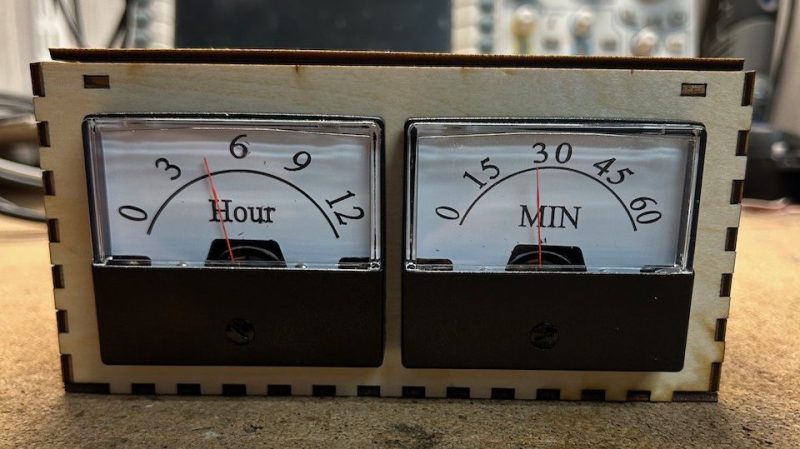When it comes to educational electronic projects, it’s hard to go past building a clock. You learn tons about everything from circuit concepts and assembly skills to insights about the very nature of time itself. And you get a clock at the end of it! [hamblin.joe] wanted to do a simple project for kids along these lines, so whipped up a neat design using analog meters to display the time.
The build relies on that old stalwart, the Arduino Uno, to run the show. It’s hooked up to a DS3231 real-time clock module so it can keep accurate time for long periods, as is befitting a clock. Displaying the time is done via the use of two analog meters, each fitted with a custom backing card. One displays hours, the other, minutes. The analog meters are simply driven by the PWM outputs of the Arduino.
It’s not a hugely complex project, but it teaches so much. It provides an opportunity to educate the builders about real-time clocks, microcontroller programming, and even the concepts behind pulse width modulation. To say nothing of the physical skills, like learning to solder or how to assemble the laser-cut enclosure. Ultimately, it looks like a really great way for [hamblin.joe] and his students to dive into the world of modern electronics.

















But can Gen-Zers tell time on it? ;-)
My nephew, born 1999, only groks digital clocks.
Whenever I do anything with clocks or 7 segment displays I get accused of making a bomb.
I’m thinking I should buy some craft supplies and make a clock that looks like a…
But then I remember somebody would report me and I’d have the cops busting down my door for a clock.
https://hackaday.com/2019/12/29/analog-meter-clock-uses-parts-from-a-simpler-time/
https://hackaday.com/2019/01/29/follow-the-bouncing-needles-of-this-analog-meter-clock/
https://hackaday.com/2021/09/10/ic-clock-uses-ammeters-for-a-unique-time-telling-display/
Nothing new. Always repeating the same thing.
Each of those is a different twist on the idea. I have no problem with seeing another.
Did you stop playing FPS games because everything after Wolfenstein was just repeating the same thing?
Bet you are fun at hackathons…
Please show us your latest original project, always interested
I’d fake the analog meters with servos, but only because I’ve more unused servos at hand than unused analog meters.
Isn’t the number of hours in a day equal to 24 ?
Depends on the planet.
Solar-based optical hour detection is employed.
To wit, look outside. Is dark? Is 10 AM. Is light? Is 10PM.
Yes, fails seasonally, and towards Arctic Circle. Not point of this clock. Real clocks have network connection for ntp, or multiple local sources to be stratum 1 ntp servers. But this is still fun.
Real clocks have an oscillator and keep time themselves otherwise they’re a remote client to a clock.
Needs another meter for that Roman gift that keeps on giving headaches for some and it’s holdover into counting and math.
This is the only 0 to 12 hour “dial” I’ve ever seen. It should start with 12 and end with 12 as well. That may not make sense but so with Roman numbering not having zero.
In a week or two we will screw with our clocks and then will have the sun till 10PM in west Indiana where Pi can change and the sun sets late. Yee Haw!
I talk about 24 hours in the build notes for the project. 24 hours would too cluttered on the meter (display), the other option would be to have a LED (or something) to show AM/PM. I could easy update the laser STL to add this. I challenged the kids with this as “extra credit”. When you do something like this you have to be very aware of how much time everything takes.